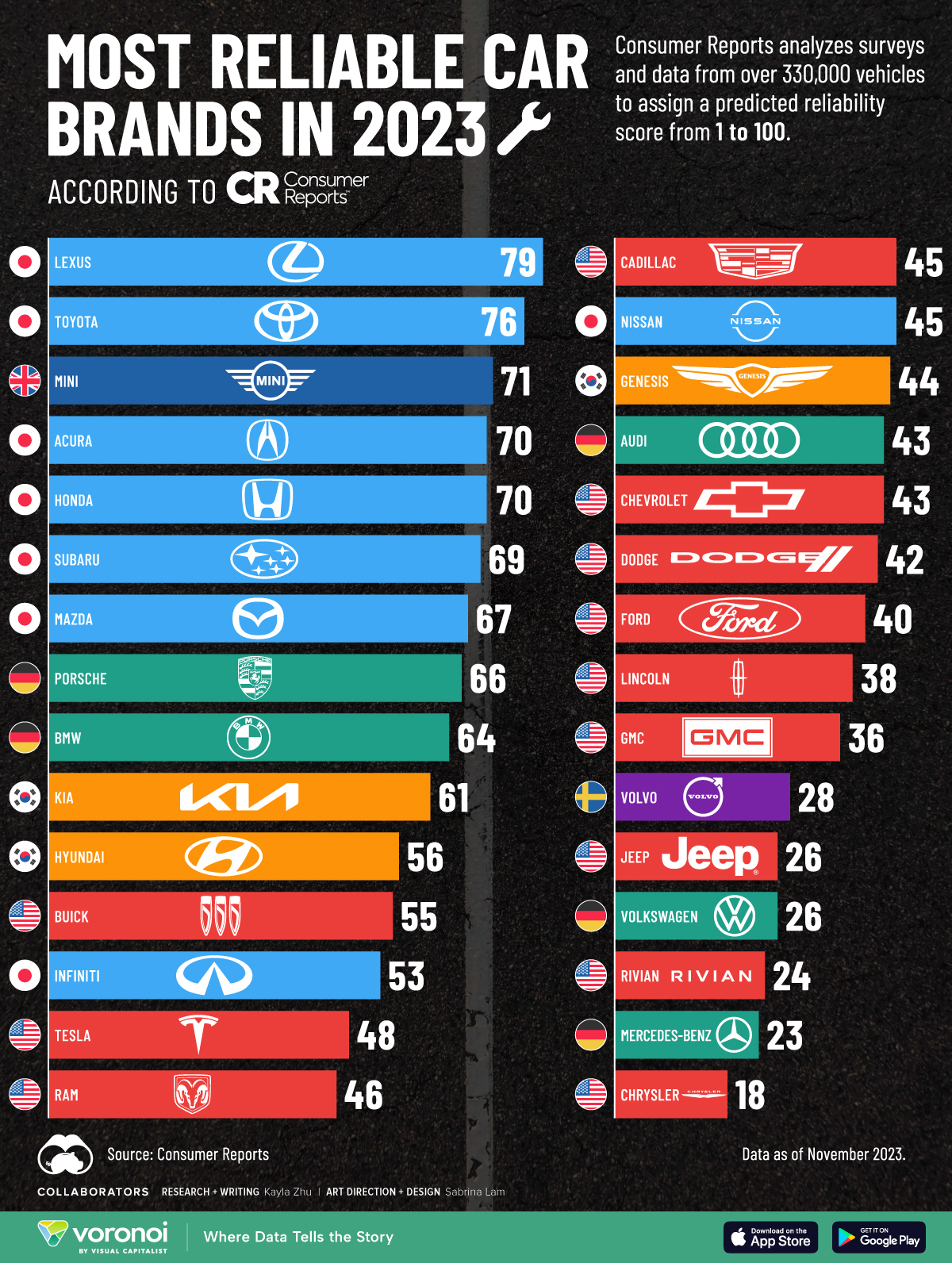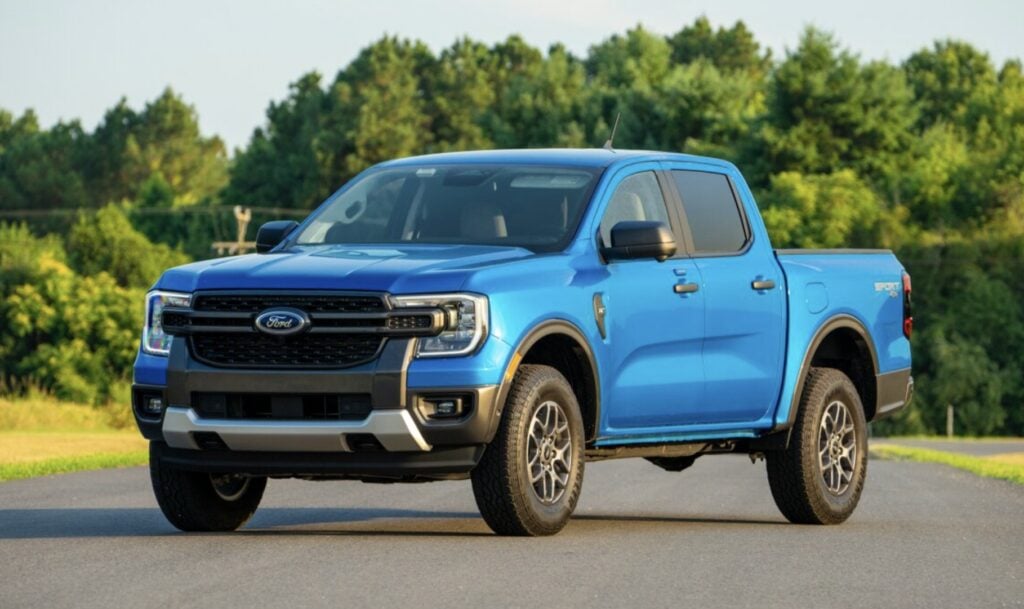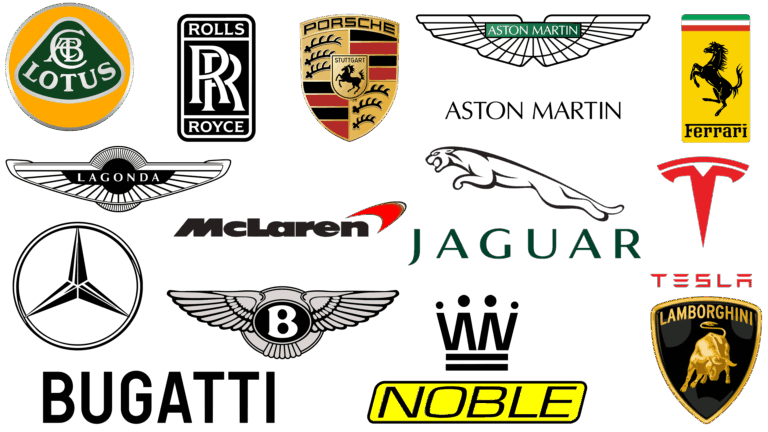Consumer Reports Most Reliable Car Brands: Your Ultimate Guide to Automotive Dependability
Consumer Reports Most Reliable Car Brands: Your Ultimate Guide to Automotive Dependability cars.truckstrend.com
In the vast and often overwhelming landscape of car buying, one metric consistently rises to the forefront of consumer concern: reliability. Beyond fuel economy, horsepower, or infotainment features, the peace of mind that comes with owning a vehicle unlikely to leave you stranded or drain your savings with unexpected repairs is invaluable. This is where Consumer Reports (CR) steps in, acting as an indispensable beacon of unbiased information. For decades, CR, an independent, non-profit organization, has been the gold standard for evaluating automotive reliability, providing car buyers with data-driven insights derived from the real-world experiences of hundreds of thousands of vehicle owners.
Understanding Consumer Reports’ "Most Reliable Car Brands" isn’t just about knowing which brands consistently top the charts; it’s about appreciating the rigorous methodology behind these rankings, recognizing the nuances of what constitutes reliability, and leveraging this knowledge to make one of the most significant purchasing decisions of your life. This comprehensive guide will delve into CR’s unique approach, unveil the brands that consistently earn their stripes, offer practical advice on applying this information, and address common misconceptions, ensuring you’re well-equipped to drive away in a dependable vehicle.
Consumer Reports Most Reliable Car Brands: Your Ultimate Guide to Automotive Dependability
Understanding Consumer Reports’ Reliability Methodology
Consumer Reports’ authority in automotive reliability stems from its unique, owner-driven data collection process. Unlike other publications that might rely on initial quality surveys or anecdotal evidence, CR’s reliability ratings are built upon a massive annual subscriber survey.
How the Data is Gathered: Each year, CR surveys its vast subscriber base, asking them to report any problems they’ve encountered with their vehicles over the past 12 months. This survey covers an extensive range of vehicle components and systems, typically spanning 17 common trouble spots. These include:
- Engine: Major and minor issues.
- Transmission: Major and minor issues.
- Drive System: AWD/4WD components.
- Suspension: Shocks, struts, springs.
- Brakes: Rotors, calipers, ABS.
- Exhaust System: Mufflers, catalytic converters.
- Climate System: AC, heater, defroster.
- Body Integrity: Squeaks, rattles, leaks.
- Body Hardware: Doors, windows, locks.
- Power Equipment: Power seats, windows, mirrors.
- In-Car Electronics: Infotainment, navigation, connectivity.
- Advanced Driver-Assistance Systems (ADAS): Lane keeping, blind-spot monitoring.


Scoring and Prediction: Each reported problem is weighted based on its severity (e.g., a transmission rebuild is far more impactful than a loose trim piece). The data from these surveys, covering models from the past 10 years, is then aggregated to calculate a predicted reliability score for each new model year. This score is presented on a 0-100 point scale, with 100 representing perfect reliability. An average score is around 41-60 points.

Why This Methodology is Robust:
- Real-World Experience: The data comes directly from owners who live with their vehicles daily, reflecting actual ownership experiences rather than showroom impressions.
- Large Sample Size: CR collects data on hundreds of thousands of vehicles annually, providing statistically significant insights across a wide range of makes and models.
- Independence: As a non-profit organization that accepts no advertising or free products from manufacturers, CR’s ratings are entirely unbiased, serving only the consumer’s interest.
- Longitudinal Data: By collecting data over several years for the same models, CR can track trends and identify consistent problem areas or improvements.
This meticulous approach ensures that Consumer Reports’ reliability rankings are among the most credible and influential in the automotive industry, providing a reliable compass for navigating the car market.
The Hall of Fame: Top Reliable Car Brands According to Consumer Reports
While specific rankings can shift slightly year by year due to new models, redesigns, or the resolution of past issues, a consistent pattern emerges from Consumer Reports’ reliability data. Certain brands have established themselves as perennial leaders, earning a reputation for building dependable vehicles that stand the test of time.
Historically, Japanese brands have dominated the top echelons of CR’s reliability charts, a testament to their focus on mature engineering, stringent quality control, and a philosophy of continuous improvement.
- Lexus: Toyota’s luxury arm frequently claims the top spot, consistently delivering vehicles with exceptional build quality and minimal reported problems. Their commitment to refined, proven powertrains and a less-is-more approach to bleeding-edge tech often translates into superior long-term dependability.
- Toyota: The parent company itself is a consistent high-flyer. Toyota’s reputation for bulletproof reliability is well-earned, with models like the Camry, RAV4, and Corolla repeatedly demonstrating remarkable longevity and low maintenance needs. Their strategy of evolving rather than revolutionizing models contributes significantly to their reliability.
- Mazda: In recent years, Mazda has surged in reliability rankings, often challenging the traditional leaders. This improvement is attributed to their focus on elegant, yet simple engineering, robust Skyactiv powertrains, and a commitment to quality that belies their mainstream pricing.
- Honda: While sometimes experiencing minor dips, Honda remains a strong contender. Brands like the Civic, CR-V, and Accord are generally known for their durability, efficient engines, and balanced performance.
- Subaru: With its standard all-wheel-drive systems, Subaru has carved out a niche for itself, consistently delivering reliable vehicles, particularly favored in regions with challenging weather. Models like the Forester and Outback are known for their robust construction.
Beyond these perennial leaders, other brands have shown significant improvement or maintain a respectable showing:
- Hyundai and Kia: These Korean brands have made tremendous strides in quality and reliability over the past decade, often rivaling their Japanese counterparts.
- BMW and Mini: Surprisingly to some, BMW and its Mini brand have shown notable improvements in reliability in recent years, demonstrating that European luxury brands can also climb the ranks by refining their complex systems.
- Acura: Honda’s luxury division typically mirrors its parent company’s strong reliability performance.
Why These Brands Excel:
- Proven Technology: Many top-ranking brands prioritize using well-tested, mature powertrains and components rather than rushing unproven technologies to market.
- Quality Control: Meticulous manufacturing processes and rigorous testing protocols contribute to fewer defects.
- Evolutionary Design: Instead of radical redesigns every few years, many reliable brands opt for incremental improvements, allowing them to iron out kinks before major overhauls.
- Focus on Fundamentals: A strong emphasis on core engineering, durability, and ease of maintenance.
Conversely, some brands, particularly those introducing cutting-edge technology or undergoing significant redesigns, may experience lower initial reliability scores as new systems encounter teething problems. However, it’s crucial to remember that brand-level reliability is a general indicator, and individual model performance can vary.
Beyond the Brand: Factors Influencing Individual Car Reliability
While brand reputation provides a strong starting point, relying solely on a brand’s overall reliability score can be misleading. A brand known for dependability might still produce a specific model with problematic components or a new design that hasn’t fully matured. To make the most informed decision, consider these model-specific factors:
- Model-Specific Reliability: Always look up the reliability rating for the specific model and year you are considering on Consumer Reports’ website. A brand’s overall high score is an average; one new or complex model could drag it down, or an older, simpler model could buoy it. New redesigns, in particular, often have lower initial reliability as manufacturers work out early production kinks and software glitches. It often takes a year or two for a new design to reach its full reliability potential.
- Powertrain Variations: Within the same model line, different engine and transmission combinations can have varying reliability records. For instance, a naturally aspirated engine might be more reliable than a turbocharged one, or a conventional automatic transmission might be more robust than a continuously variable transmission (CVT) or a dual-clutch automatic.
- Technology Integration: Modern cars are packed with complex electronics, from vast infotainment screens to sophisticated advanced driver-assistance systems (ADAS). These systems, while convenient and safety-enhancing, are increasingly common sources of problems reported to CR, often involving glitches, freezes, or false alarms. Simpler trims or models with less cutting-edge tech may exhibit fewer electronic issues.
- Production Location: While less impactful than design and engineering, sometimes the plant where a vehicle is assembled can have a minor influence on initial quality.
- Owner Maintenance: This is perhaps the most critical long-term factor. Even the most reliable car will suffer if neglected. Adhering to the manufacturer’s recommended maintenance schedule (oil changes, fluid checks, tire rotations, brake inspections) is paramount for preserving a vehicle’s longevity and reliability. Using quality parts and certified mechanics also contributes significantly.
By delving into these granular details, you move beyond broad brand strokes to understand the specific dependability of the vehicle you’re interested in, ensuring a more accurate prediction of your ownership experience.
Practical Applications: Using CR Data for Your Car Purchase
Armed with Consumer Reports’ reliability data, you have a powerful tool at your disposal. Here’s how to integrate this information into your car-buying journey for maximum benefit:
- Start with Your Needs and Budget: Before diving into reliability charts, define your core requirements: vehicle type (sedan, SUV, truck), passenger capacity, fuel economy needs, safety features, and, crucially, your budget. Reliability is a key factor, but it shouldn’t be the only factor.
- Filter by Reliability: Once you have a shortlist of vehicles that meet your basic criteria, use Consumer Reports’ website or magazine to check their predicted reliability scores. Focus on models with "Above Average" or "Much Above Average" ratings. Pay close attention to the specific trouble spots reported for each model; for example, if a model consistently has transmission problems, that’s a major red flag.
- Balance Reliability with Other Factors: A car might be incredibly reliable but not meet your other needs (e.g., too small, poor fuel economy, unengaging to drive). Use CR’s comprehensive reviews to weigh reliability against performance, safety ratings, owner satisfaction, fuel efficiency, and features.
- Consider New vs. Used: CR’s reliability data is invaluable for both new and used car purchases. For used cars, looking at the reliability history of past model years can give you a strong indication of potential long-term issues. For new cars, paying attention to how a brand handles new redesigns (waiting a year or two for kinks to be ironed out) can be a smart strategy.
- Test Drive Thoroughly: Reliability data tells you about potential problems, but it doesn’t tell you how a car feels to drive. Always test drive your shortlisted vehicles extensively to ensure they meet your comfort, handling, and performance expectations.
- Get a Pre-Purchase Inspection (for Used Cars): Even if a used car has a stellar reliability record, a professional pre-purchase inspection by an independent mechanic is a wise investment. They can spot current issues that might not have been reported to CR or indicate future problems.
- Don’t Chase Perfection: No car is 100% problem-free. Reliability aims to minimize unexpected and costly repairs. Even highly reliable cars will require routine maintenance. Focus on finding a vehicle that offers a strong balance of reliability, features, and overall value for your specific lifestyle.
By systematically applying CR’s insights, you empower yourself to make a well-informed decision that leads to long-term satisfaction and fewer headaches down the road.
Addressing Challenges and Misconceptions
While Consumer Reports’ reliability data is an invaluable resource, it’s important to approach it with a nuanced understanding and be aware of common misconceptions:
- Misconception: Reliability Means Zero Repairs: No vehicle is immune to wear and tear or the occasional unexpected issue. High reliability means a lower probability of experiencing unexpected and costly repairs, particularly those related to major components like the engine or transmission. Routine maintenance (oil changes, tire rotations, brake pad replacements) is still essential and is not counted as a "problem" in CR’s surveys.
- Challenge: New Models vs. Established Ones: As mentioned, brand-new models or significantly redesigned vehicles often have lower initial reliability scores. Manufacturers need time to identify and fix issues that only become apparent after thousands of units are on the road. If cutting-edge features or a completely new design are paramount, be prepared for a slightly higher risk of early-life glitches.
- Challenge: Electric Vehicle (EV) Reliability: The landscape of EV reliability is still evolving. While EVs have fewer moving parts (no engine, transmission, exhaust system), they introduce new potential trouble spots, primarily related to charging systems, battery management, and complex in-car electronics. CR is actively tracking EV reliability, and current data suggests that while the drivetrains are generally robust, issues often arise from software glitches and power equipment.
- Solution: Wait and See: If top-tier reliability is your absolute priority, consider waiting a year or two after a major model redesign or the introduction of a completely new technology. This allows manufacturers to issue software updates, refine production processes, and address any initial widespread issues reported by early adopters.
- Complexity vs. Simplicity: Often, simpler vehicles with fewer complex electronic systems or less innovative powertrains tend to be more reliable simply because there are fewer things that can go wrong. While advanced features are appealing, they can sometimes come with a reliability trade-off.
By understanding these nuances, consumers can set realistic expectations and make more strategic choices, ensuring that their pursuit of a reliable vehicle is both informed and successful.
Table: Overview of Consistently High-Ranking Car Brands by Consumer Reports
| Brand | Key Reliability Trait | Common Models Known For Reliability | Typical Maintenance Cost (General) | Target Audience/Value Proposition |
|---|---|---|---|---|
| Lexus | Exceptional Build Quality, Refined & Proven Tech | RX, ES, GX, NX, LS | Moderate (for luxury segment) | Luxury, Comfort, Utmost Dependability, Strong Resale Value |
| Toyota | Bulletproof Drivetrains, Mature Engineering, Durability | Camry, RAV4, Corolla, Highlander, Prius | Low | Practical, Long-Term Value, Excellent Resale, Worry-Free Ownership |
| Mazda | Simple & Elegant Engineering, Robust Skyactiv Tech | Mazda3, CX-5, CX-30, MX-5 | Low to Moderate | Engaging Drive, Premium Feel, Reliable Quality, Good Value |
| Honda | Balanced Performance, Durability, Efficient Engines | Civic, CR-V, Accord, Pilot | Low | Versatility, Efficiency, Dependability, Strong Resale Value |
| Subaru | Standard AWD, Robust Components, Safety Focus | Forester, Outback, Crosstrek, Ascent | Moderate | Outdoor Enthusiasts, All-Weather Capability, Safety, Durability |
| BMW | Improved Engineering, Quality Control, Driving Dynamics | 3 Series, X5, 5 Series, X3 (recent models) | Moderate to High (for luxury) | Performance, Luxury, Driving Engagement, Improving Reliability |
| Mini | Fun-to-Drive, Improved Components | Cooper (Hardtop, Countryman), Clubman | Moderate | Unique Style, Agility, Compact Luxury, Better Recent Reliability |
Note: This table provides general observations based on historical Consumer Reports data and brand reputation. Specific model reliability can vary significantly, and maintenance costs are estimates that depend on model, mileage, and service provider. Always check the latest Consumer Reports data for specific models and years.
Concluding Summary
In the complex world of automotive purchases, Consumer Reports stands as an unparalleled resource for understanding vehicle reliability. By meticulously collecting data from hundreds of thousands of real-world owners, CR provides unbiased, actionable insights that empower consumers to make informed decisions. While brands like Lexus, Toyota, and Mazda consistently lead the pack due to their commitment to proven technology and quality control, it’s crucial to remember that reliability is also model-specific and influenced by factors like new designs and owner maintenance. By leveraging CR’s comprehensive data, balancing reliability with personal needs, and adopting smart buying strategies, you can significantly enhance your chances of driving a dependable vehicle that offers long-term satisfaction and invaluable peace of mind. Investing in a reliable car isn’t just about saving money on repairs; it’s about investing in a hassle-free ownership experience.
Frequently Asked Questions (FAQ)
Q1: How often does Consumer Reports update its reliability ratings?
A1: Consumer Reports typically releases its updated reliability rankings annually, usually in the fall. These updates incorporate data from the latest subscriber surveys and reflect any shifts in performance for new or existing models.
Q2: Does CR test every car on the market for reliability?
A2: CR’s reliability ratings are based on owner surveys, not CR’s own testing. However, CR does conduct extensive road tests and evaluations of hundreds of new vehicles each year, which contribute to their overall vehicle ratings that factor in performance, safety, and owner satisfaction, alongside reliability data.
Q3: Are luxury cars less reliable than mainstream cars?
A3: Not necessarily. While some luxury brands, particularly those with highly complex new technologies, might initially experience more issues, others like Lexus (Toyota’s luxury brand) consistently rank at the very top for reliability. The key often lies in the complexity of the vehicle’s systems and the maturity of its design.
Q4: Does reliability mean I won’t have to do any maintenance?
A4: No. Reliability refers to the likelihood of experiencing unexpected repairs or component failures. All vehicles, regardless of their reliability rating, require routine maintenance (e.g., oil changes, tire rotations, brake pad replacement, fluid checks) to ensure longevity and optimal performance. Neglecting scheduled maintenance will significantly diminish any car’s reliability.
Q5: How important is reliability for resale value?
A5: Reliability is a major factor in a car’s resale value. Vehicles with a strong reputation for dependability tend to hold their value better over time because buyers are willing to pay more for the peace of mind that comes with a car less likely to incur costly repairs. This is especially true for popular models from top-ranked brands.
Q6: What about electric vehicle (EV) reliability according to Consumer Reports?
A6: EV reliability is an evolving picture. While EVs generally have fewer moving parts (no engine, transmission, exhaust system), CR’s data shows that issues often arise from charging systems, in-car electronics, and power equipment. Some established EV manufacturers and traditional automakers with newer EV models have had mixed results. As the technology matures, expect EV reliability to improve and stabilize.





